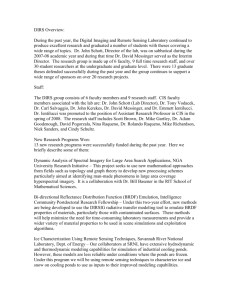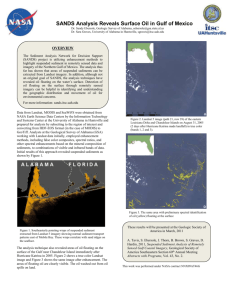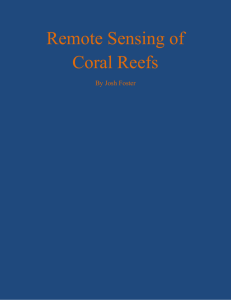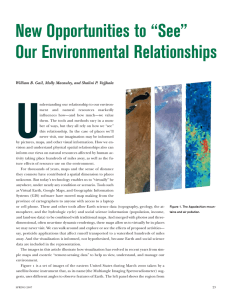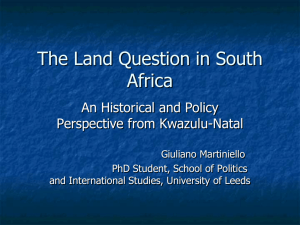MAPPING RURAL LAND USE IN SELECTED... OF SOUTH AFRICA, USING REMOTE SENSING PRODUCTS.
advertisement
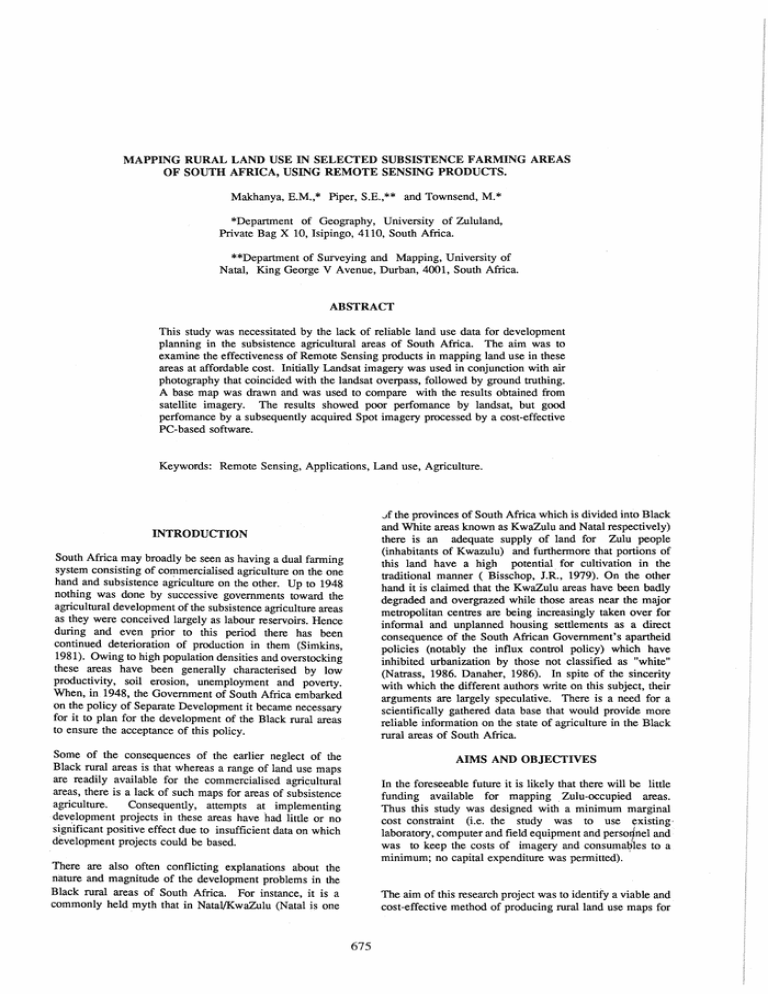
MAPPING RURAL LAND USE IN SELECTED SUBSISTENCE FARMING AREAS OF SOUTH AFRICA, USING REMOTE SENSING PRODUCTS. Makhanya, E.M.,* Piper, S.E.,** and Townsend, M.* *Department of Geography, University of Zululand, Private Bag X 10, Isipingo, 4110, South Africa. **Department of Surveying and Mapping, University of Natal, King George V Avenue, Durban, 4001, South Africa. ABSTRACT This study was necessitated by the lack of reliable land use data for development planning in the subsistence agricultural areas of South Africa. The aim was to examine the effectiveness of Remote Sensing products in mapping land use in these areas at affordable cost. Initially Landsat imagery was used in conjunction with air photography that coincided with the landsat overpass, followed by ground truthing. A base map was drawn and was used to compare with the results obtained from satellite imagery. The results showed poor perfomance by landsat, but good perfomance by a subsequently acquired Spot imagery processed by a cost-effective PC-based software. Keywords: Remote Sensing, Applications, Land use, Agriculture. Jf the provinces of South Africa which is divided into Black and White areas known as KwaZulu and Natal respectively) there is an adequate supply of land for Zulu people (inhabitants of Kwazulu) and furthermore that portions of this land have a high potential. for cultivation in the traditional manner ( Bisschop, J.R., 1979). On the other hand it is claimed that the KwaZulu areas have been badly degraded and overgrazed while those areas near the major metropolitan centres are being increasingly taken over for informal and unplanned housing settlements as a direct consequence of the South African Government's apartheid policies (notably the influx control policy) which have inhibited urbanization by those not classified as "white" (Natrass, 1986. Danaher, 1986). In spite of the sincerity with which the different authors write on this subject, their arguments are largely speculative. There is a need for a scientifically gathered data base that would provide more reliable information on the state of agriculture in the Black rural areas of South Africa. INTRODUCTION South Africa may broadly be seen as having a dual farming system consiSting of co~mercialised agriculture on the one hand and subsistence agriculture on the other. Up to 1948 nothing was done by successive governments toward the agricultural development of the subsistence agriculture areas as they were conceived largely as labour reservoirs. Hence during and even prior to this period there has been continued deterioration of production in them (Simkins, 1981). Owing to high population densities and overstocking these areas have been generally characterised by low productivity, soil erosion, unemployment and poverty. When, in 1948, the Government of South Africa embarked on the policy of Separate Development it became necessary for it to plan for the development of the Black rural areas to ensure the acceptance of this policy. Some of the consequences of the earlier neglect of the Black rural areas is that whereas a range of land use maps are readily available for the commercialised agricultural areas, there is a lack of such maps for areas of subsistence agriculture. Consequently, attempts at implementing development projects in these areas have had little or no significant positive effect due to insufficient data on which development projects could be based. AIMS AND OBJECTIVES In the foreseeable future it is likely that there will be little funding available for mapping . Zulu-occupied areas. Thus this study was designed with a minimum marginal cost constraint (Le. the study was to use ~xisting· laboratory, computer and field equipment and perso~nel and was to keep the costs of imagery and consuma~les to a minimum; no capital expenditure was permitted). There are also often conflicting explanations about the nature and magnitude of the development problems in the Black rural areas of South Africa. For instance, it is a commonly held myth that in Natal/KwaZulu (Natal is one The aim of this research project was to identify a viable and cost-effective method of producing rural land use maps for 675 PREVIOUS WORK DONE IN THIS AREA the areas of subsistence agriculture that could provide basic infonnation on the nature of land use in these areas. For this purpose the efficacy and cost-effectiveness of two technologies was compared. We investigated the relative merits of high altitude aerial photography and satellite imagery in a study area on the periphery of Durban, Natal. The Department of Surveying and Mapping of the University of Natal had for some time prior to this project been engaged in research concerning landsat capabilities for the mapping of land use and land cover in selected areas of Natal/K.waZulu. On the other hand the Geography Department of the University of Zululand had been doing land use studies of the region by airphoto interpretation. In June 1985 the two departments received sponsorship from the Council for Scientific and Industrial Research (CSIR) to undertake a joint project with the purpose of sharing both resources and expertise in gathering more knowledge about the usefulness of Landsat applications in the region. Durban, a city on the east coast of southern Africa (Figure I) was chosen because of its rapid population growth and urbanization in the 1970s and 1980s which makes it one of the fastest urbanizing centres in the world. In particular, the area inland from Umlazi, and slightly to the south, known as Umbumbulu (Figure 2) was selected for specific study because: We therefore knew the area well and were aware of some! of the limitations of landsat applications in areas where the average size of land parcels were small (Makhanya, 1986. Piper & Scogings, 1984). After reviewing landsat applications for rural land use in other developing countries we took note of the various problems that we could encounter (van Genderen, et al., 1978. Eden & Parry, 1986. Collins & van Genderen, 1978); We noted that Studies made in Nigeria showed that, in spite of its limited applications to rural land use in the developing countries, Landsat could be used cost-effectively for crop inventories in these areas (Taylor & Blowers, 1983. Adeniyi, 1986.). Landsat was also applied with a major of success for crop inventories in commercialised agricultural areas of South Africa where the land parcels were considerably large (Malan & Turner, 1983. Makhanya, 1983). We expected some measure of success with our project because the peasants in our study area cultivated sugar cane (a cash crop) intensively. So that, even though the individual land parcel sizes averaged about 1.76 ha., they were contiguous fonning large continuous areas of the same crop. We had seen enhanced landsat images of a sugar cane estate area in Swaziland (about 350 km North of our study area on the same meridian) in which the crop could be readily identified. We included in our study area the large Illovo sugar estate that we intended to use as a control to our results. A) It is an urban spill-over zone from Umlazi, one of the few fonnal settlement areas for Zulu people in Durban B) There is a substantial population of subsistence farmers in the Umbumbulu hinterland C) There is currently a shift from subsistence to cash-crop agriculture in Umbumbulu, and D) The areas surrounding Umbumbulu are largely devoted to commercial agriculture, mainly sugar-cane. From a knowledge of the region and prior study we expected to find the following classes of land cover: sugar-cane, grassland, coastal forest, open water bodies, dense urban areas (i.e. planned) and dense rural settlements (i.e. unplanned). The primary objective of the study was to compare two remote sensing technologies for providing land cover maps at a reconnaissance scale of 1 in 250 000; this scale being most useful for primary planning in the region. STUDY AREA The landscape around Durban and south to Umbumbulu is undulating and the natural vegetation varies from open grassland to dense coastal forest. The annual rainfall is about 1020 mm p.a. and occurs mainly during the summer when maximum temperatures are about 30 degrees C. The area is characterised by a high degree of cloudiness. The countryside is heavily dissected by steams and rivers and soil erosion varies from slight to moderate. METHODOLOGY Initially two sources of imagery were chosen for evaluation: high altitude aerial photography and satellite imagery. Aerial photography. Panchromatic aerial photography was obtained from 'Job Sur 100/86' flown by Air Survey Co. of Durban for the KwaZulu administration on 22 May 1986. The photo-scale was approximately 1 in 150000 on standard 23 em prints were acquired. This particular photography was chosen because the flying date coincided with the LANDSAT overpass, the scale was appropriate for mapping at the desired reconnaissance level and the resultant number of prints needed for photo-interpretation was small. The imagery was interpreted and annotated using> a mirror stereoscope and the land cover classes transferred to a map using a zoom transfer-scope. The Umbumbulu study area is predominantly rural with few urban settlements and included both subsistence and cash-crop agriculture. Both modes of agricultural are characterized by homesteads dispersed among cultivated fields and grazing lands. Because of the undulating terrain there are many patches which are not suitable for cultivation; these are areas of semi-open veld (i.e. sc~b-grassland) and this veld is a continuously varying mIxture of grasses and bushes and their are few stands of pure grass or bush. As a consequence of the traditional Zulu land-allocation system and the high population densities the average allotment to each cash-crop farmer is 1.76 ha; all land is communally held and there is no individual land ownership. These small fann-parcel sizes are confound~d by the uneven terrain to produce extremely small plot SIzes. On the adjacent commercial farms (ownership restricted to those classified as "white") the field sizes are much bigger and the fanns are extensive. The dominant cash-crop in both systems is sugar cane. Satellite Imagery. At the time this study was planned thhe was only one type of satellite imagery available in southern Africa, i.e. from the multispectral scanner (MSS) on board the LANDSAT satellite. The Satellite Applications Centre (SAC) of the CSIR in South Africa was able to capture a cloud-free 676 interspersed cultivation. image of the study area (WRS 168-81), on 21 May 1986. From this scene the following products were acquired: a colour composite (bands 4, 5 and 7 as blue, green and red) paper print at 1 in 250 000; three black and white (B/W) filD\ negatives of bands 4, 5 and 7, all at 1 in 1 000 000 and a computer compatible tape (CCT) of the three bands. -.- From this map the four test areas were examined for use as SRD but one was rejected as it lay slightly outside the study area. Satellite imagery. On the enlarged B/W images in green (band 4) and red (band 5) it was possible to discern urbanization features (e.g. highway, airport, major factories) and the limits of the formal Zulu settlements of Umlazi and KwaMakhuta. Major shopping centres and larger industrial estates could be delineated. On the B/W infrared image (band 7) the water bodies came out strongly as did some of the communication routes, however fewer features were positively identified. ( From each B/W negative enlargements at 1 in 100 000 were made. After selecting a training area the prints were visually examined and interpreted. Thereafter the entire study area was checked for ground truth. The false-colour composite was then interpreted. A search was made for areas which were uniform in terms of their hue, saturation, intensity and texture. Each such area was given an identifying number. The false colour composite was found to yield 16 distinct and uniform cover classes selected on the basis of their spectral and textural .characteristics. There was an extensive elimination of small areas; the smallest area shown on Fig. 2 is about 3.2 km across on the ground (about 2 mm on the map) and this is equivalent to just over 1 000 ha on the ground. The CCT was loaded into the portable image processing suite (i.e. PIPS: O'Donnoghue et al. 1983) running on a SPERRY-UNIVAC computer. The image was geometrically registered to the map projection used in the study area (Forbes et al. 1983). This was achieved by choosing 13 ground control points (GCP) uniformly spread across the image. The image was also radiometrically enhanced for visual analysis. The pixels were resampled to 100 m by 100 m and placed on a true north-south grid. From an examination of the false-colour composite it was recognized that it would be difficult to identify sufficiently pure and large training area for supervised classification. Thus an unsupervised clustering algorithm (ISODATA: Ball and Hall 1965) was chosen. Once the information class had been identified the whole study area was classified using a bayes a priori classifier (Swain, 1978). The computer classifications were spatially noisy and were cleaned by the application of a 3 by 3 pepper-and-salt majority filter. TABLE 1. PEARSONS CORRELATION COEFFIENCE OF THE RESULTS OBTAINED FROM VISUAL INTERPRETATION WITH THE BASE MAP. Category The manual interpretation of the B/W imagery was taken into the field and three test areas were checked and revised to provide maps which could be used as surface reference data (SRD, i.e. "ground-truth"). These SRD maps were digitized and converted to raster images congruent with the satellite imagery. A direct spatial comparison of the computer classifications with the SRD was then possible. The accuracy of classification was measured using the Jaccard coefficient (Piper, 1983). As the pepper-and- salt filter smooths regional boundaries a zero-one mask was created which was one everywhere except when within 2 pixels of a class boundary on the SRD. This mask was then applied to both the SRD and the computer classification so as to remove the deleterious effects of filtering which accurrs along the boundaries between uniform regions. Band 5 Sugar 0,15 0,27 -0,01 0,36 Forest 0,24 0,29 0,31 0,18 Township 0,54 0,50 0,56 0,50 Rural Homestds 0.00 0,00 0,00 0,03 Water 0,00 0,00 0,16 0,06 Mixed 0,11 0,16 -0,03 0,53 Band 7 Color The visual comparison of bands 4, 5 and 7 and the false-colour composite with the SRD showed that the MSS scene did not have the detail necessary to map the desired land use classes. There were low correlation coefficients between the visually interpreted classes and the base map. However, the township category showed a correlation coefficient of over 50% on all four images while the mixed category mapped at over 50% on the false-colour composite. The computer clustering yielded four, eight and five spectral classes for test areas one, two and three respectively RESULTS (Figure 3). In each set of signatures it is seen that there is a water-like signature (No. 1 in each) and a pure vegetation signature showing the red-edge characteristic of healthy vegetation (No. 4 in each). There are at least two intermediate, or mixed pixel classes in each set (No.s 2 and 3). The Illovo Sugar Mill test area gave four rather strange signatures (No.s 5-8) (Associated with the sea-shore edge). For each of the three test areas the confusion matrices have been portrayed diagrammatically. BIW imagery. The photo-interpretation yielded a large number of potential surface cover classes for the entire study region. After field checking it was possible to simplify these to six cover classes. A) and other B) C) D) E) F) Band 4 Predominantly sugar-cane with patches of grass cultivation, Coastal forest, Mixed grass, trees and pockets of cultivation, Open water bodies and sea, Dense urban areas (planned), Dense rural settlements (unplanned) with In 1990 we acquired a PC-based DRAGON software (Nadeau, T. & Goldberger, K., 1990). We used this software to process floppy disk scenes from the study area 677 Bristol, U.K. that we obtained from the CSIR. We could thereby readily identify all the land use categories reflected on the base map with a level of accuracy of about 90% (Plate 1). Nadeau, T. & Goldberger, K., (Goldin-Rudahl Systems), 1990. Dragon Image Processing System. Decision Images, Inc. NJ, U.S.A. CONCLUSION Natrass, J., et ai, 1986: An Anatomy of Rural Black Poverty: The Challenge to a New Economic Order. Conference Paper, Univ. of York Centre for Southern African Studies. In conclusion it may stated that landsat was found unreliable for mapping rural land use in the study area. The failure of landsat to discriminate the extensively raised sugar cane crop was probably due to dense vegetation cover and the ruggedness of the land. However, it was found that the high resolution Spot image could be used effectively for semi-detailed rural land use mapping in this area. This could also be done at affordable costs using a PC-based software. O'Donoghue, D., et ai, 1983. PIPS: A geo-coded Remote Sensing Image Processing Suite. Edis 83 Proceedings, 19-20 Sept., Pretoria. Piper, S.E., 1983. The PIPS Primer for Remote Sensing Applications, 1ed. Dept. of Surv. and Mapping, Univ. of Natal, Durban. REFERENCES Adeniyi, P.O., 1986. Agricultural Land Use Inventory and Mapping in Nigeria: the Application of Remote Sensing. In: Eden, M.J., & Parry J.T., (eds). Remote Sensing and Tropical Land management, John Wiley, Chichester. pp. 175-187. Piper, S.E., & Scogings, D.A., 1984. A Pilot Study to Evaluate the Feasibility of constructing Half Yearly Medium Scale Landcover Maps of Selected Non-urban Areas of Natal Using Remote Sensing Data. Dept. of Surv. & Mapping, Univ. of Natal, Durban. Ball, G.H., & Hall, D., 1965. Isodata, a Novel Method of Data Analysis and Pattern Classification. Clearing House for Federal Scientific and Technical Information. Springfield, Virginia. Simkins, c., 1981. Agricultural Production in the African Reserves. Journal of Southern African Studies, 7(2):256283. Bisschop, J.R., 1979. South Africa: Two Agricultures? Social Dynamics, 5(2):29-31. Swain, P.H., & Davis, S.M., 1978. Remote Sensing: The Quantitative Approach. McGraw-Hill, NY. Collins, W.G., & van Genderen, J.L., 1978. Remote Sensing. Applications in Developing Countries, Conference Proceedings, RSS, Sheffield. Taylor, J.C., & Blowers, S., 1983. Satellite Image Analysis Applied to Land Use Identification in Northern Nigeria. Conference Proceedings, Remote Sensing For Rangeland Monitoring and Management, RSS, Silsoe. Danaher, K., 1986. Bantustan Agriculture in South Africa: Obstacles to Development under a Post-Apartheid Government. Conference Paper, Univ. of York Centre for Southern African Studies. Van Genderen, J.L., et aI, 1978. Guidelines for Using Landsat Data for Rural Land Use Surveys in Developing Countries, ITC Journal, 1978-1. pp. 30-47. Eden, M.J., & Parry, J.T., (eds.), 1986. Remote Sensing and Tropical Land Management. John Wiley, Chichester. Forbes, A.M.F., et ai, 1984. Simple Techniques for Geocoding and Radiometrically Correcting Adjacent Landsat Images. Unpublished Report, Dept. of Surv. & Mapping, Univ. of Natal, Durban. Makhanya, E.M., 1983. The Effectiveness of Digitally enhanced Images in the Production of Agricultural Land Use Maps for the Less Developed Areas. Edis 83 proceedings, 19-20 Sept., Pretoria. Makhanya, E.M., 1986. Agricultural Land Use Mapping in Lesotho: Problems and Limitations of Landsat, in Eden, M.J., & Parry, J.T. (eds), op cit. pp 215-222. Malan, O.G., & Turner, B., 1983. The Heilbron Crop Mapping Project, Part 11 1980-81, CSIR Special Report PIS 303, Pretoria. Moreno, J.F., et al., 1989. Making, Checking and updating inventories of Citrus Crop Areas by means of Spot Data in the Mediterranean Region of Spain, In: Remote Sensing for Operational Applications, Technical Contents of the 15th Annual Conference of the Remote Sensing Society, Univ. of 678 30°5 The Study Area N f 31°5 Umtala o 168-81 landsat image TRANSKEI w w ~ 0M N o N M ° KWAZULU AREA Fig.l w w M 0 50 100km ~I===========I~========~I location of study area 679 N o 10 20km cl==================±I================~1 A Sugarcane with patches of grass and other cultivation B Coastal Forest c Mixed grass, trees and pockets of cultivation D Water bodies E Dense F Dense rural settlements (unplanned) with cultivation urban areas (planned) Source : 1986 Airphotos, 1986 Landsat Image, 1986-7 Field Checking Fig. 2 Compiled basemap of study area 680 Nungwane S RD Dam class S RD Water class Water Urban 2 Urban 2 Fore 51 3 Fa rest 3 Sugar 4 Sugar 4 Mixed Mixed Illovo Sugar Mill <1 I> 1 Water Urban 2 Urban 2 Forest 3 Forest 3 Sugar B Sugar B Mixed ['> Mixed M k 0 m a z.i Urban Ri v e r Urban Fore s t 2 Forest 2 Sugar 3 Sugar 3 Mixed 4 Mixed 4 5 Informal 5 Water W,tller --1-19 Fig. 3 -20-29 - 30-39 _ _ _ 40 - 100 per cent Comparison of basemap and computer classes 681 1. Sugar Cane 2. River 3. Sediment 4. Peri-Urban 5. Rural Village with Gardens 6. Mixed Grass and Trees 7. Roads Plate 1. Unsupervised Classification of a Colour Composite Spot Image. 682

